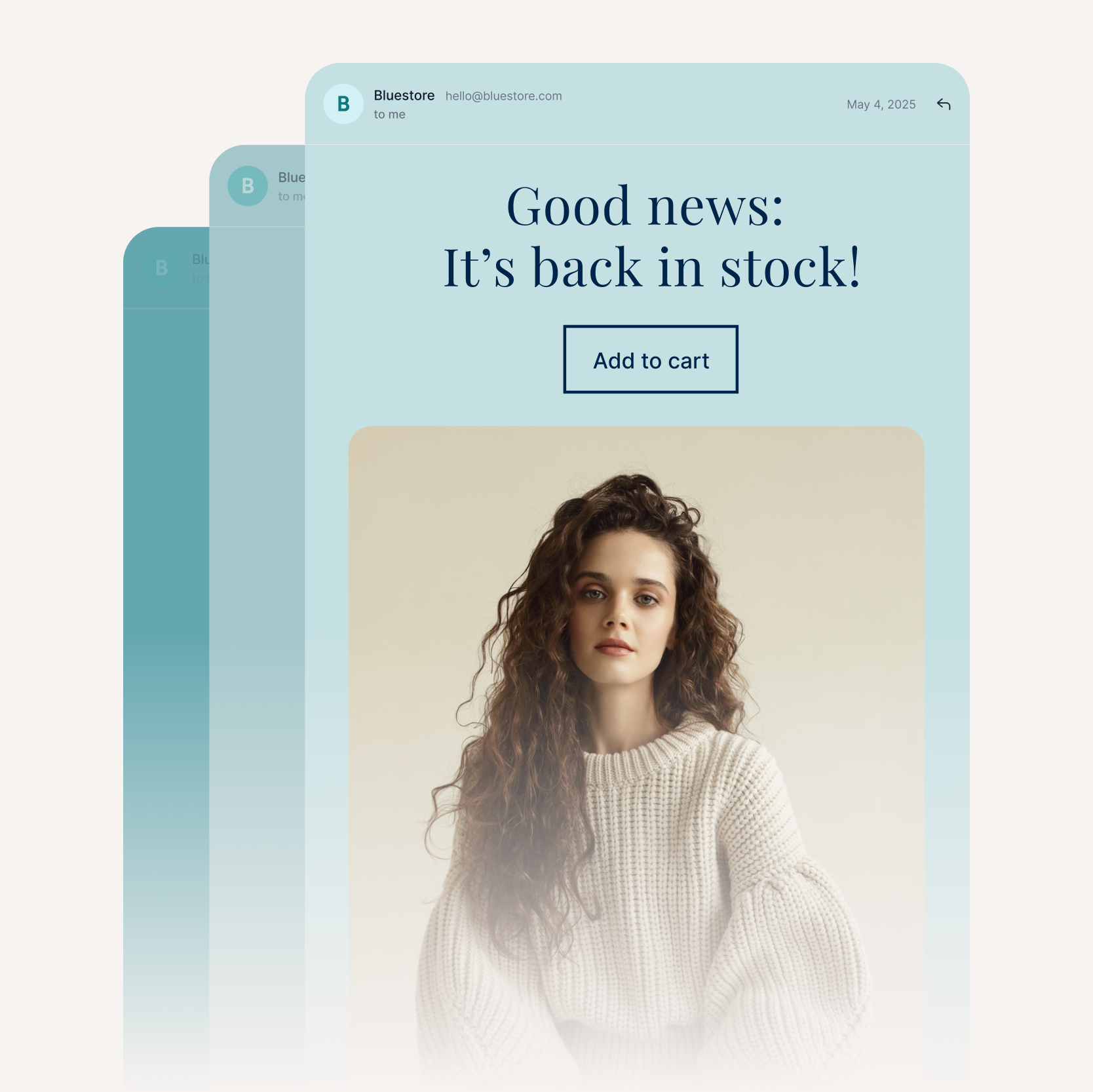Triggers are one of retail’s most overlooked growth engines.
Every retailer sends welcome and cart abandonment emails, which are effective — but limited in scope. Though triggers deliver high ROI, most retailers still don’t use them to their full potential.
To unlock the power of triggers, retailers must adopt a future-forward mindset. Imagine a strategy where triggers go beyond recovering single sales and balance with batch sends to create personalized, multi-channel engagement throughout the entire shopper lifecycle.
Beyond the transaction: A new approach to retail triggers
Many retailers struggle to leverage triggers for two reasons:
- Triggers are treated as reactive tools. Retailers often focus on bottom-of-funnel tactics like cart abandonment or welcome emails, overlooking proactive triggers such as replenishment reminders, loyalty milestones, or birthday messages that drive engagement earlier in the customer journey.
- Triggers often operate in silos. When triggers are not aligned with broader batch strategies, they risk becoming disconnected and less impactful. Let your batch campaigns dominate, and they’ll overshadow triggers and lead to email fatigue, unsubscribes, and missed opportunities for meaningful engagement.
To move beyond traditional trigger tactics, retailers need to embrace a new way of thinking — one that elevates triggers from isolated touchpoints to an integrated strategy that enhances every stage of the customer lifecycle.
Start with these five pivot points.
Shift from campaigns to signals
A modern email strategy moves beyond reacting to customer actions and instead anticipates their needs. By leveraging real-time signals — from product views to wishlist additions — retailers can proactively guide shoppers through their journey with timely, relevant messages.
For example, instead of waiting for a customer to abandon their cart, an AI shopping agent like alby can engage as soon as a shopper signals intent. If a customer lingers on a product page but doesn’t add to cart, alby can step in with tailored recommendations, styling suggestions, or product comparisons. This approach positions triggers as a seamless extension of the customer journey rather than a last-ditch attempt to recover sales.
Treat triggers as a conversation, not a campaign
Triggers should be a natural extension of a dialogue with your customers. Unlike batch sends, which are often one-way, triggers create opportunities for back-and-forth engagement. Each customer signal becomes a chance to respond thoughtfully and build the relationship.
For example, when a shopper views a product but doesn’t add it to their cart, a well-timed trigger can send a “Still considering this?” email featuring reviews, stock updates, or similar recommendations.
With alby’s AI-powered email integration, these conversations can happen directly within the email itself. Instead of static content, customers can see prompts for questions about fit, material, shipping timelines, or alternative recommendations. By aligning triggers with agentic AI, retailers make it easier for customers to get the answers they need, reducing hesitation and increasing the likelihood of conversion.
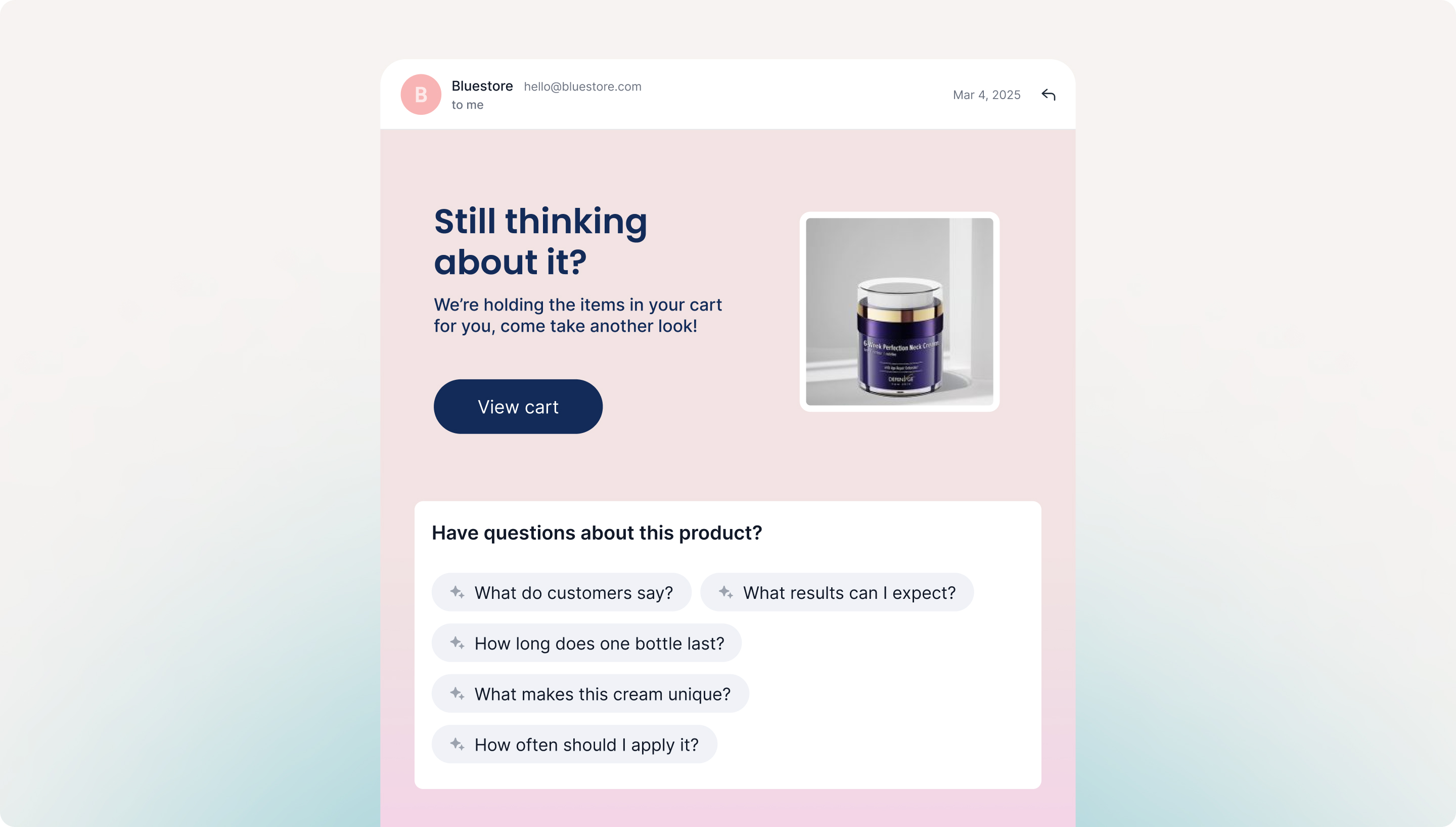
Expand triggers to multi-channel engagement
Email might be the backbone of most trigger strategies, but it shouldn’t be the only channel. Retailers can unlock more value by expanding triggers across SMS, push notifications, on-site overlays, and paid media.
For instance:
- A shopper browsing a website receives a personalized overlay suggesting related products.
- An abandoned cart trigger is followed up with an SMS reminder offering free shipping.
- A post-purchase email is reinforced with a targeted social media ad showcasing complementary items.
Combine this multi-channel approach with an AI shopping agent to recognize and respond to shopper signals across every touchpoint.
Think beyond the immediate purchase
Retailers often think of triggers as tools for driving transactions, but their potential goes far beyond that. Triggers can be used to create meaningful touchpoints throughout the customer lifecycle, deepening relationships and building loyalty.
Consider proactive triggers like:
- Low-stock alerts: Let high-intent shoppers know when an item they’ve browsed is running low, creating urgency and driving faster decisions.
- Post-purchase care: Offer care instructions, usage tips, or complementary product recommendations to enhance their experience.
- Loyalty exclusives: Alert loyal customers about early access to VIP sales, member-only events, or special product drops, reinforcing their status and driving repeat engagement.
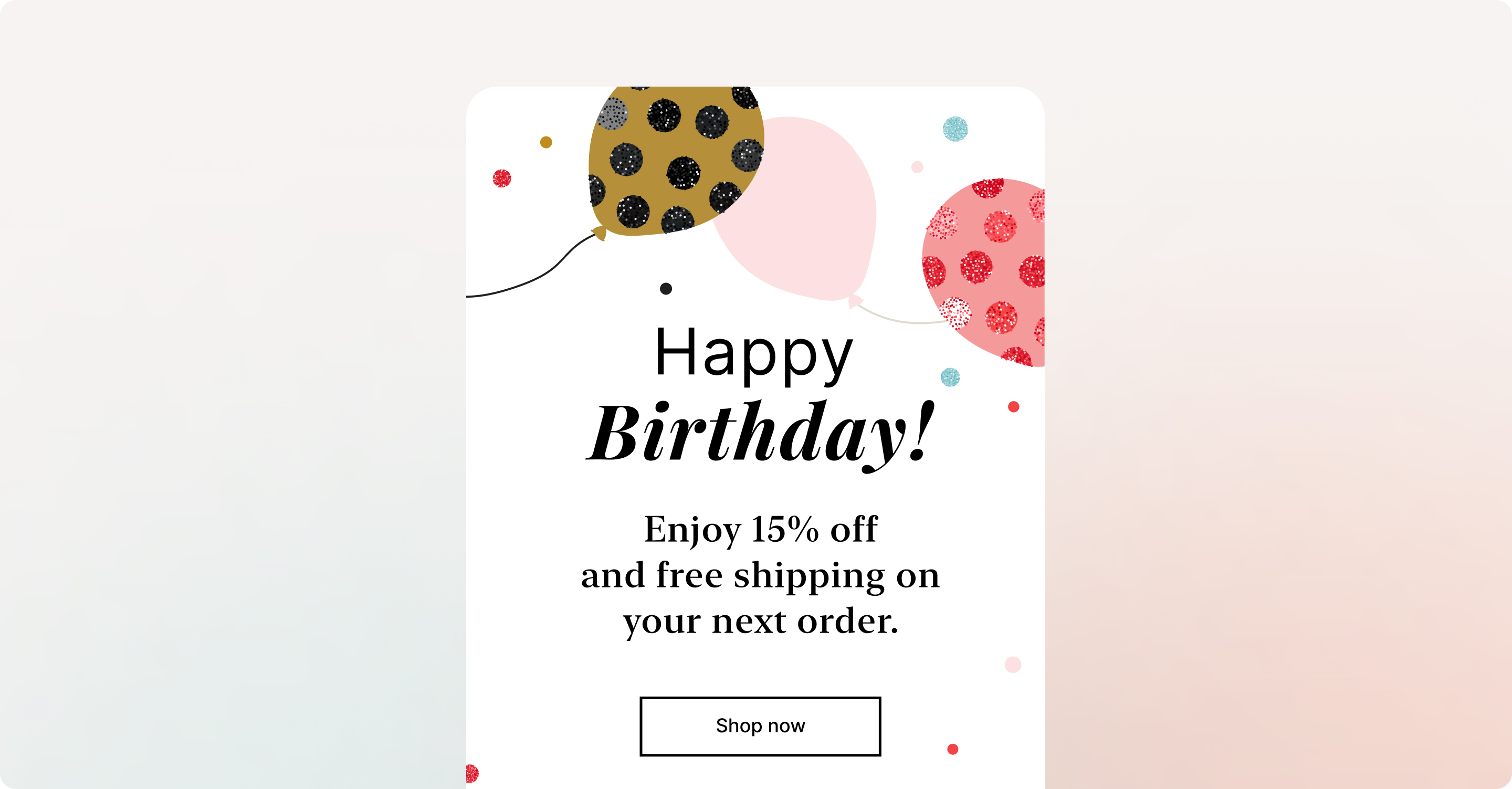
Adopt a service-first mindset
The most effective trigger strategies don’t just sell — they serve. Retailers who treat triggers as an extension of their customer service strategy can create experiences that feel helpful, not pushy. By focusing on customers’ needs, triggers enhance the shopping journey, build trust, and increase loyalty.
For instance:
- Helpful reminders: Replenishment triggers can remind customers to reorder essentials before they run out, turning convenience into loyalty.
- Educational content: Post-purchase triggers can include care tips, setup guides, or styling inspiration to help customers make the most of their purchases.
- Celebratory messages: Birthday or loyalty anniversary triggers show customers they’re valued, creating a sense of connection and driving high levels of engagement.
Balancing batch campaigns and triggers for better results
Batch campaigns and triggers play vital roles in retail marketing but serve different purposes. Batch campaigns excel at creating broad awareness and driving traffic, while triggers shine when delivering timely, personalized follow-ups that nurture engagement and conversions.
When used together, they create a seamless customer journey, generating excitement, deepening engagement, and increasing conversions.
Triggers drive higher engagement and revenue
Triggers respond to real-time shopper behavior, making them inherently personalized and timely. This ability to react to actions like browsing history, wishlist additions, or purchase patterns ensures customers receive messages that feel relevant, not random.
As a result, triggers often outperform batch campaigns in metrics like sales-per-recipient and engagement rates while maintaining lower unsubscribe rates.
Batch campaigns spark interest, triggers deepen it
While triggers are tailored to individual actions, batch campaigns serve a different role: creating broad awareness and excitement. A batch email announcing a seasonal sale or new product launch can inspire customers to explore your site, but the triggers pick up the conversation and deliver personalized experiences.

Avoid batch overload
Retailers risk overwhelming their audience when they rely too heavily on batch campaigns to drive short-term results. High email volumes can lead to fatigue and unsubscribes, diminishing your ability to engage customers long-term.
The key: Triggers and batch campaigns work together
The most effective strategies treat batch campaigns and triggers as complementary tools. Use batch campaigns to generate awareness and excitement, then let triggers continue the conversation with personalized, timely follow-ups.
For example, consider a fashion retailer launching a new summer collection. A batch email can generate excitement by showcasing the collection’s standout pieces — vibrant dresses, lightweight blazers, and seasonal accessories. This broad message grabs attention and encourages customers to explore the collection online.
From there, triggers take over to deliver personalized follow-ups. A customer who clicks on blazers receives a tailored email featuring coordinating pieces, such as linen pants or matching shoes, while another customer browsing dresses sees complementary accessories like handbags or statement jewelry. Meanwhile, an SMS trigger alerts a high-value customer about early access to the collection, creating an exclusive shopping experience.
This coordinated approach balances reach and personalization, ensuring every communication feels intentional and relevant. By weaving batch campaigns and triggers into a seamless strategy, you drive conversions alongside customer trust and loyalty.
Trigger strategies: a full-funnel, dynamic approach
A world-class trigger strategy starts with a dynamic, full-funnel approach that transforms every customer signal into meaningful engagement. By connecting triggers across the entire shopper journey, retailers can deliver seamless, personalized experiences that spark interest, drive conversions, and build lasting loyalty.
Here’s how to implement this strategy at every stage of the funnel.
Top of funnel: build awareness and capture interest
At the top of the funnel, the goal is to introduce your brand and engage potential customers before they’re ready to buy. Triggers in this stage should create opportunities to connect and guide shoppers closer to conversion.
Use triggers to act on early interest signals, such as product views or email sign-ups. This is your chance to turn passive interest into active engagement by delivering personalized experiences that stand out from competitors.
Consider these triggers:
- Welcome triggers: The first touchpoint matters. When a shopper signs up for emails, a well-timed welcome message introduces your brand, highlights key products, and (if applicable) delivers an incentive. This turns new sign-ups into first-time buyers.
- New-to-sale triggers: When an unknown shopper visits the sale section, trigger a follow-up showcasing best sellers or newly discounted items. This helps convert deal-seekers and keeps them engaged with fresh inventory.
- Abandoned search triggers: If a shopper searches for a product but leaves without clicking on a result, follow up with personalized recommendations based on their search intent. Help them pick up where they left off.
Mid-funnel: drive consideration and move toward purchase
In the mid-funnel, shoppers are weighing their options. Triggers at this stage should focus on guiding customers toward decision-making while addressing potential hesitations or friction points.
Think of this stage as an opportunity to reinforce relevance. Personalize triggers based on browsing behaviors, category affinities, or previous interactions to highlight products or services that align with the customer’s needs. The focus is building confidence and urgency to move them closer to purchase.
Consider these triggers:
- Browse abandonment: Re-engage shoppers who left your site by reminding them of the products they viewed and including helpful details like reviews or complementary items to reignite their interest.
- Price drop alerts: Notify customers when prices drop on items they’ve browsed or saved, emphasizing urgency with messaging like “Limited time offer.”
- Back-in-stock alerts: Let shoppers know when previously sold-out items they viewed or saved are available again. To encourage quick action, pair the notification with a message like “Good news! Your favorite item is back, but stock is limited.”
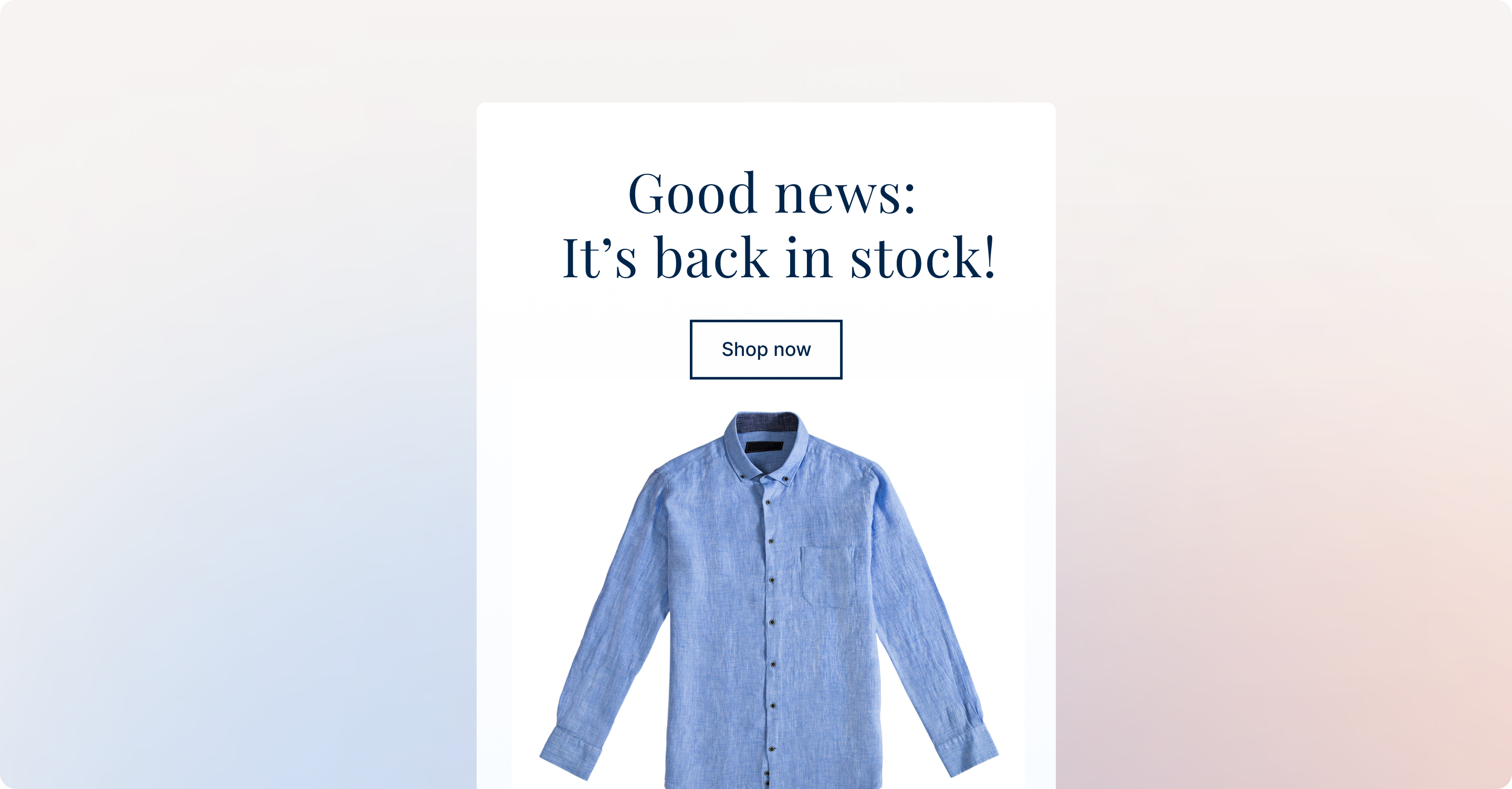
Bottom of funnel: convert and strengthen the relationship
At the bottom of the funnel, triggers help close the deal and set the stage for long-term loyalty. A thoughtful approach ensures every customer touchpoint, from checkout to post-purchase, reinforces trust and encourages repeat engagement.
Go beyond closing the sale by positioning triggers as tools to deliver value beyond the transaction. Post-purchase engagement keeps customers engaged and makes their experience feel uniquely tailored.
Consider these triggers:
- Cart and checkout abandonment: Follow up with shoppers who leave or abandon items in their cart. Use reminders to highlight key product details, offer incentives like free shipping, or emphasize urgency with messages like “Your cart is waiting, but stock is running low.”
- Post-purchase engagement: Keep the conversation going after the sale with thank-you messages, care instructions, or personalized recommendations for complementary products. For example, suggest accessories for a recently purchased smartphone or highlight a rewards program to encourage repeat purchases.
- Review requests: Encourage customers to leave feedback on their recent purchases. For example, “We’d love to hear what you think about your new [product]. Share your thoughts and help others.”
Across the funnel: align triggers with the entire customer journey
A truly optimized trigger strategy doesn’t treat funnel stages in isolation. It considers how each interaction builds on the last, creating a cohesive journey that balances short-term wins with long-term growth.
By leveraging predictive modeling, retailers can anticipate customer needs before they act. Insights like Next Best Purchase, for example, help retailers surface relevant recommendations based on past behaviors, increasing the likelihood of repeat purchases and deeper engagement.
Then, use signals from one stage to inform the next. For instance, signals from early funnel engagement (like browsing categories) can shape mid-funnel recommendations, while post-purchase signals can feed back into top-of-funnel retention strategies.
Consider these triggers:
- Winback campaigns: Reignite interest with lapsed customers by offering exclusive discounts or highlighting new arrivals tailored to their past preferences. For example, “We miss you. Here’s 15% off to rediscover your favorites.”
- Time-bound messages: Deliver timely, relevant messages for occasions like replenishment or birthdays. Remind customers to restock essentials before they run out or celebrate their special day with a personalized offer.
- Personalized seasonal promotions: Leverage customer data to deliver season-specific offers that align with their preferences. For example, recommend cozy winter gear to cold-weather shoppers or tech accessories for holiday gifting, ensuring your messaging stays timely and relevant throughout the year.
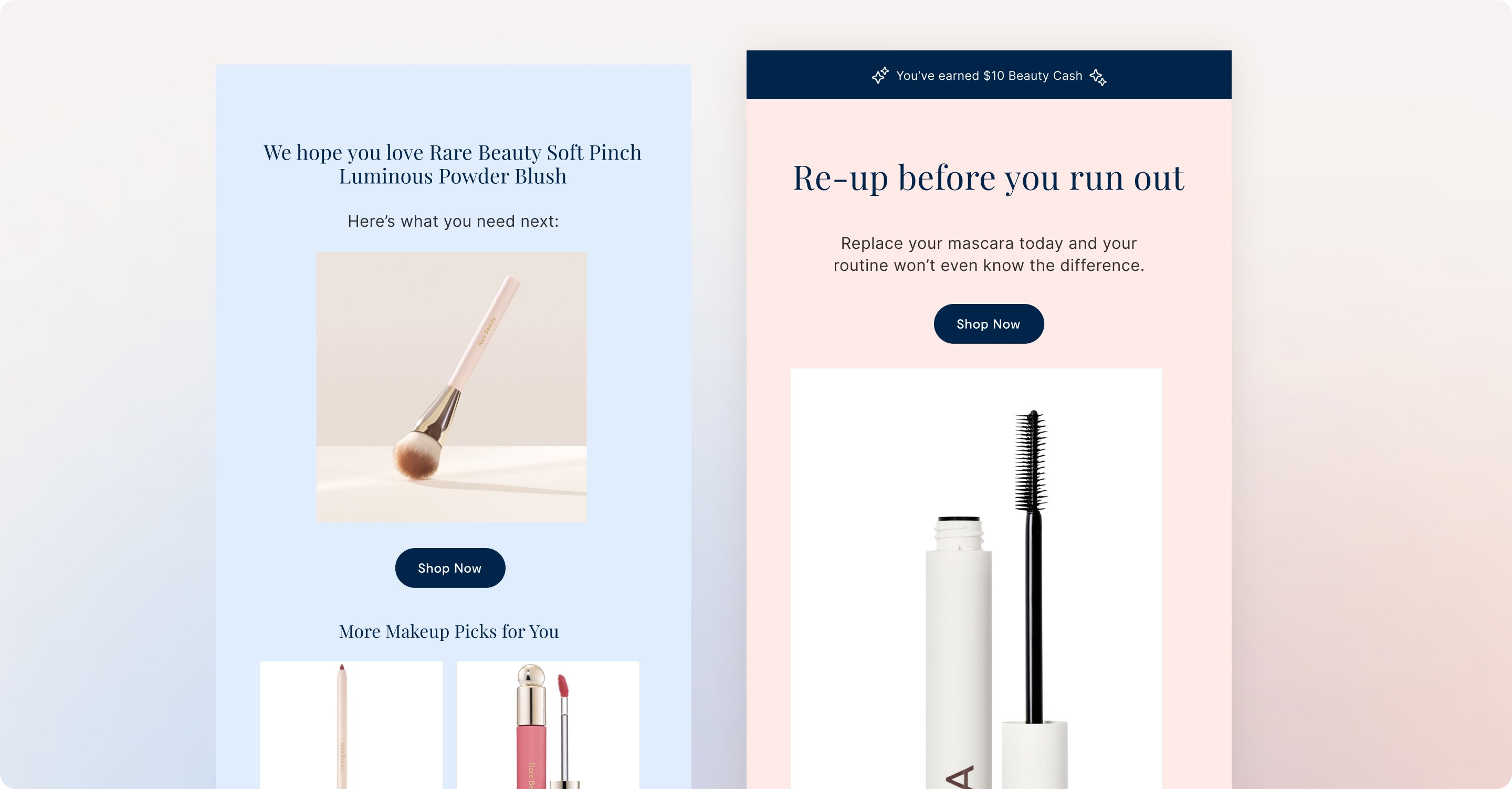
Putting it all together
The stakes for retailers have never been higher. Shoppers expect seamless, personalized experiences at every turn. Failure to meet expectations and capture valuable buyer attention leads to lost revenue, diminished loyalty, and falling behind competitors.
With a modernized trigger strategy, you have the power to do more than just recover carts. You can re-engage lapsed customers, build trust through thoughtful touchpoints, and deliver timely messages that drive short-term conversions and long-term loyalty.
Ready to see alby in action?
Get started with a free proof of concept.
Get started Get started with a free proof of concept.


